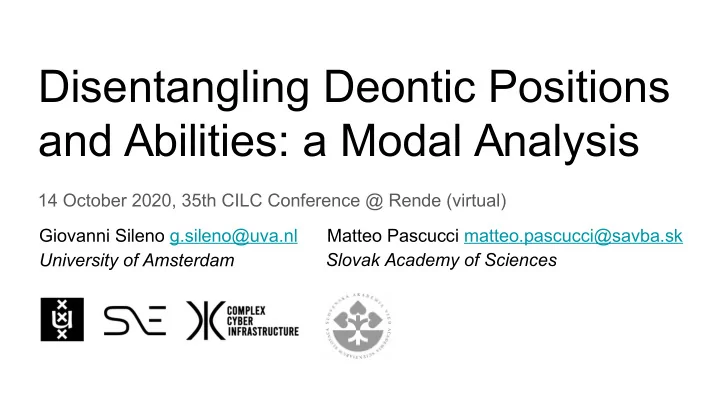

Disentangling Deontic Positions and Abilities: a Modal Analysis 14 October 2020, 35th CILC Conference @ Rende (virtual) Giovanni Sileno g.sileno@uva.nl Matteo Pascucci matteo.pascucci@savba.sk University of Amsterdam Slovak Academy of Sciences
From individual devices to digital social systems... Digital Markets Social networks Distributed Ledgers Internet of Things
...from “mechanical” to institutional approaches to computation... not instructions, but contracts , regulations , laws .. detail of Babbage’s Analytical Engine the medieval port of Genoa, flourishing with the introduction of insurances, contract options and other mechanisms of risk management (finite) Turing machine
Contribution of the paper ● a language of multimodal logic with ○ alethic operators (w.r.t. simultaneous nodes) ○ temporal operators (w.r.t. successive nodes) ○ deontic operators involving no form of quantification capturing Hohfeld’s framework of normative positions ● first results on rendering fundamental coordination mechanisms ● proofs of soundness and completeness
Normative specifications (I): Control Models example from Apache webserver configuration
Normative specifications (II): Deontic Logic
Normative specifications (III): Hohfeld’s framework duty-holder claimant power-holder power-subject
Types of normative specifications: Comparison Control models Deontic Logic Hohfeld’s framework permission X X X prohibition X X X obligation X X power/ability X 1 party 1 party 2 parties actions situations actions focus on
Performer vs Observer perspectives action-type def add(a, b): resource/object c = a + b c is set global c observer/monitor add(1, 3) agent to 4 command consequence system was agent refined action allowed to do so? perform 1 + 3 am I enabled to do so? write result in c am I allowed to do so? is agent enabled- allowed to do so? permission power/ability
Ability focus on situations ● Analytical literature ○ Brown [1988] ○ Brown [1992] ○ eg. Horty & Belnap [1995] ● Psychological literature ○ eg. Chemero [2003] ● Robotic literature ○ Sahin et al. [2007] ● initiates in Event Calculus focus on behaviour/actions there is an analytical gap w.r.t. ability defined on actions!
Proposed Language all successive alternative nodes configuration object agent all simultaneous refined alternative nodes action-type (with objects)
Configurations and propositions ● We consider a special object “*” for the whole system . Configurations of the whole can be used to introduce 0-ary predicates in the language: ● Vice versa, we can associate configurations of the whole system with the propositional formulas describing them: [Φ is here constrained not to contain any to to avoid recursion]
Ability as directed change the target outcome is not it is possible for the agent present in all successive to perform the action nodes in all simultaneous if the agent alternatives... and the target then the target performs the outcome is not outcome is present action present in all successive nodes
Ability as directed change the target outcome is not it is possible for the agent present in all successive to perform the action nodes CONTERFACTUALITY SUFFICIENCY in all simultaneous if the agent alternatives... and the target then the target performs the outcome is not outcome is present action present in all successive nodes
Ability as directed change the target outcome is not it is possible for the agent present in all successive to perform the action nodes CONTERFACTUALITY SUFFICIENCY in all simultaneous if the agent alternatives... and the target then the target performs the outcome is not outcome is present action present in all successive nodes we define similarly negative ability (inhibiting an outcome)..
Disability as uncontrollability ● Disability, positive and negative abilities can be used to introduce further notions as enabling and disabling actions, interference , etc.
Normative components ● We extend the language by allowing a finite prefixing sequence of deontic operators of the type (directed obligation) is obligatory for x (duty-holder) w.r.t. y (claimant or claim-holder) ● We use the standard definitions of prohibition and permission:
Axiomatic Calculus ● We consider a calculus specified by the following axioms/rules: ● Proven to be sound and complete w.r.t. its standard models.
Hohfeld’s original framework only actions performed by the duty-holder only creation of obligations
Hohfeld’s extended framework any formula any conjunction of normative positions
Examples of use: Sale contract
Examples of use: Data protection
Examples of use: Exclusive delegation
Conclusion ● The paper reports on a research effort unifying insights from modal logic and normative systems , having in mind applications of complex cyber infrastructures and socio-technical systems. ● Key message: deep entrenchment between deontic and potestative categories, and the second ones are required to model complex coordination constructs (e.g. delegation). ● Future developments : investigation of enforcement mechanisms, of the relation of power with conditional obligations, introduction of objects/agents roles and more complex forms of refined actions.
Disentangling Deontic Positions and Abilities: a Modal Analysis 14 October 2020, 35th CILC Conference @ Rende (virtual) Giovanni Sileno g.sileno@uva.nl Matteo Pascucci matteo.pascucci@savba.sk University of Amsterdam Slovak Academy of Sciences
Recommend
More recommend